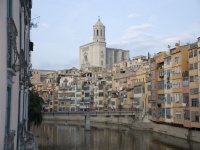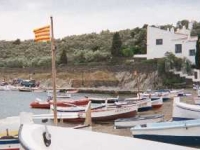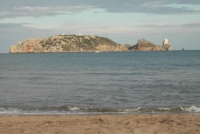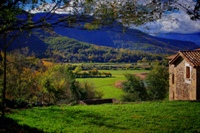Things to do in Costa Brava
The allure of the Costa Brava is the combination of crowded, manicured resorts and rugged unspoilt coastline, which offers tourists the best of both worlds through great amenities and luxury, as well as natural beauty. There are a number of Blue Flag beaches along the Costa Brava, and also some secluded, rocky coves.
The glorious beaches, in combination with the renowned food and restaurant scene, makes the Costa Brava ideal for resort holidays, with the most popular destinations including Roses, Lloret de Mar and Blanes. Tossa de Mar, a smaller, more authentic coastal resort village, is also a delight, and the bigger centres of Girona and Banyoles offer many attractions.
Visitors will find wonderful coastal walks and numerous golf courses, as well as many fun water sports, and there's quality cultural and historical sightseeing for those who are interested. Attractions include some impressive Roman and Iberian archaeological sites. The extensive ruins of the ancient Greco-Roman city, Empuries, is the highlight for many visitors.
The nearby medieval village of Sant Marti d'Empuries is also lovely to explore. Lastly, Costa Brava is Dali country and there are three museums to visit for fans of the artist, including the fascinating Salvador Dali Museum House near Cadaques.

Girona
The city of Girona, on the route from the Pyrenees to Barcelona, is one of the most important historical sites in Spain, and was founded by the Romans and later turned into a Moori…
Girona
The city of Girona, on the route from the Pyrenees to Barcelona, is one of the most important historical sites in Spain, and was founded by the Romans and later turned into a Moorish stronghold. Sitting astride the confluence of the Onyar and Ter rivers, this quaint medieval city attracts hordes of tourists from the Costa Brava resorts and Barcelona. All are lured by the experience of walking through the old quarter, the Call, with its narrow alleyways and ancient stone houses. Inside the ancient walls, visitors will find gems such as the 12th-century Benedictine monastery of Sant Pere de Galligants and the 14th-century cathedral built in the Catalonian Baroque style. The cathedral can be accessed by climbing up 90 steps. It includes a museum that contains art works and rare manuscripts.
Website www.girona.cat

Salvador Dali Museum House
The busy fishing village of Cadaques draws plenty of visitors, but they don't come for the local beach, which is rather narrow and stony. Rather, the resort town's attractions are …
Salvador Dali Museum House
The busy fishing village of Cadaques draws plenty of visitors, but they don't come for the local beach, which is rather narrow and stony. Rather, the resort town's attractions are its picturesque natural harbour, some excellent restaurants, numerous galleries, fashion, and art and craft shops, and the former home-turned-museum of world-renowned surrealist painter, Salvador Dali. Situated in nearby Portlligat Bay, Dali's bizarre home consists of a labyrinthine cluster of fishermen's huts that were added to the original building in various stages by the artist over a period of 40 years. Visitors must reserve a time for entry in advance as only about eight people are allowed in the museum at a time.

The Medes Islands
Situated scarcely a mile from the beach of the popular resort town of L'Estartit on the Costa Brava, the protected Medes Islands are seen as heaven for divers. The craggy little ar…
The Medes Islands
Situated scarcely a mile from the beach of the popular resort town of L'Estartit on the Costa Brava, the protected Medes Islands are seen as heaven for divers. The craggy little archipelago of seven islets and a few reefs form one of the most important and rich marine reserves in the Mediterranean. Meda Gran, the largest of the islands, is the only one of considerable size, and there's a 10th-century lighthouse on it. Most of the islands are just rocky outcrops jutting out of the sea, with little vegetation. However, the magic happens underwater, where millions of fish and thousands of animal and plant species inhabit the shallows, crevices and submarine caves at the base of the island cliffs.

Garrotxa Nature Reserve
Visiting the dormant volcanoes is not one of the typical things to do in Spain, yet they offer stunning scenery and a one-of-a-kind experience. Sandwiched between the Pyrenees and …
Garrotxa Nature Reserve
Visiting the dormant volcanoes is not one of the typical things to do in Spain, yet they offer stunning scenery and a one-of-a-kind experience. Sandwiched between the Pyrenees and Costa Brava, the region of Garrotxa is home to a multitude of prehistoric volcanoes as well as many castles and country houses. Visitors who want to experience more of Spain than the quintessential beach and city breaks should head to Garrotxa Nature Reserve just outside of Girona, where they can explore a land of amazing and rugged landscapes, fire and ash. The reserve showcases the best of rural tourism in Spain and is perfect for enthusiastic hikers.
Website www.turismegarrotxa.com/_es.html



